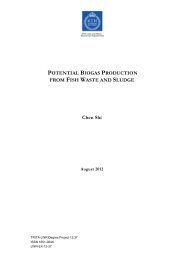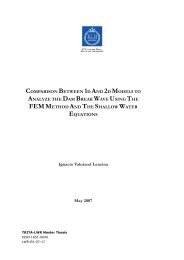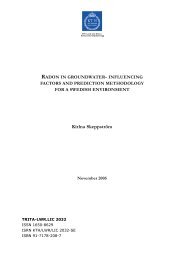water sources, infrastructure, space and the dynamics of ...
water sources, infrastructure, space and the dynamics of ...
water sources, infrastructure, space and the dynamics of ...
Create successful ePaper yourself
Turn your PDF publications into a flip-book with our unique Google optimized e-Paper software.
Water <strong>sources</strong>, <strong>infrastructure</strong>, <strong>space</strong> <strong>and</strong> <strong>the</strong> <strong>dynamics</strong> <strong>of</strong> environmental diseases in Saboba District: Using GISSpace <strong>and</strong> incidence <strong>of</strong> RTILike Malaria <strong>and</strong> Typhoid, Table 20 shows that <strong>the</strong> correlation issignificant at 0.001 between RTI <strong>and</strong> <strong>the</strong> distance to major towns inSaboba district. The explanations are that, 1) though <strong>the</strong>re are fewcars/vehicles on <strong>the</strong> highways, <strong>the</strong>ir number (usually withoutenvironmental regulations) is greater in <strong>the</strong> townships causing a lot <strong>of</strong>emissions <strong>and</strong> dust, <strong>and</strong> 2) <strong>the</strong> relative concentration <strong>of</strong> populations in<strong>the</strong> townships <strong>and</strong> <strong>the</strong> use <strong>of</strong> woodfuel for cooking exposes greaternumber <strong>of</strong> people to smoke from burning wood. The latter explains whymore women (54.5%) than men (45.5%) are affected with RTI asmentioned above. Even though, <strong>the</strong> residents in <strong>the</strong> Saboba Townshiphave better defence mechanisms such as education, wealth etc (seeconceptual framework) <strong>and</strong> are <strong>the</strong>refore able to reduce <strong>the</strong> hazards <strong>of</strong>environment, those defence mechanisms does not prevent emission <strong>and</strong>dust from vehicular movement. The third reason may be due to lowhospital attendance <strong>of</strong> <strong>the</strong> peripheral areas.There was no significant correlation between RTI <strong>and</strong> distances to roadsin Saboba district (Table 21). The only possible relationship betweenroads <strong>and</strong> respiratory diseases is through <strong>the</strong> emissions <strong>and</strong> dust fromcars/vehicular movement in <strong>the</strong> third class roads in <strong>the</strong> district.However, with few numbers <strong>of</strong> vehicles that plies <strong>the</strong> roads,characterised by potholes, serve to limit or reduce speed <strong>and</strong> thus helpedto minimise <strong>the</strong> emission <strong>of</strong> smoke <strong>and</strong> dust. However, <strong>the</strong> emissions<strong>and</strong> dust may be greater in Saboba Township due to its nodal nature interms <strong>of</strong> vehicular movement. The widespread <strong>of</strong> bushfires, <strong>the</strong> high use<strong>of</strong> woodfuel <strong>and</strong> charcoal for cooking <strong>and</strong> <strong>the</strong> kaekae (North-East tradewinds), accompanied by dust (harmattan winds) may explain <strong>the</strong>widespread <strong>of</strong> respiratory diseases in <strong>the</strong> district, irrespective <strong>of</strong>geography, except in Saboba Township, where its nodal nature invehicular movement may have worsen its case.Table 22 shows that <strong>the</strong>re is no significant correlation (0.104 levels)between RTI <strong>and</strong> l<strong>and</strong>-cover type. The reason is that; 1) Saboba districtis generally an open savannah area with similar characteristics, 2) <strong>the</strong>district is predominantly farming communities that use <strong>the</strong> slash <strong>and</strong> burnmethod <strong>of</strong> l<strong>and</strong> preparation without any geographic differences, <strong>and</strong> 3)<strong>the</strong> North-East trade winds (Harmattan) accompanied by dust affect <strong>the</strong>whole district irrespective <strong>of</strong> <strong>the</strong> location, with <strong>the</strong> exception <strong>of</strong> <strong>the</strong>relatively populated Saboba township which is more disposed torespiratory diseases due to concentration <strong>of</strong> cars/vehicles <strong>and</strong> burning <strong>of</strong>fuelwood during cooking.Position <strong>of</strong> <strong>the</strong> hypo<strong>the</strong>sisThis part validates or o<strong>the</strong>rwise <strong>of</strong> <strong>the</strong> hypo<strong>the</strong>sis <strong>of</strong> <strong>the</strong> study. Thestated hypo<strong>the</strong>sis is that;There is a significant relationship between distances to <strong>the</strong> main town, roads,<strong>water</strong>courses, <strong>the</strong> type <strong>of</strong> l<strong>and</strong> cover <strong>and</strong> elevation on one h<strong>and</strong> <strong>and</strong> environmentaldiseases on <strong>the</strong> o<strong>the</strong>r in Saboba district.Tables 13, 17 <strong>and</strong> 20 show an inverse significant relationship at 0.001levels between distances to <strong>the</strong> main town <strong>and</strong> <strong>the</strong> three leading(environmental) diseases (Malaria, Typhoid <strong>and</strong> RTI) in <strong>the</strong> district. Thismeans that environmental diseases decrease from <strong>the</strong> main town towards<strong>the</strong> periphery. Table 14 also shows that incidence <strong>of</strong> Malaria <strong>and</strong> distanceto roads has an inverse significant relationship at 0.05 levels. The reasonsfor <strong>the</strong>se trends have been stated above. However, Tables 15, 16, 18, 19,21 <strong>and</strong> 22 showed that <strong>the</strong>re is no significant relationship between45
















